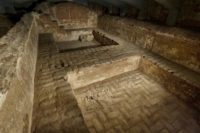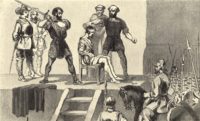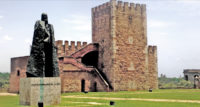 In 1992, workers excavated the tomb of Christopher Columbus in the cathedral of Santo Domingo to translate bones believes to be his (over the centuries, Columbus’ remains were moved over longer distances than any saint’s — from Valladolid to Seville to Santo Domingo to Havana and back across the Atlantic to Seville — so authentication has proven all but impossible) to their new home in the Columbus Lighthouse monument. A few meters underneath Columbus’ tomb, an older crypt was found. It had once had a vaulted brick ceiling, now damaged, but its brick floor and side walls and size (28 feet by 12 feet) attested that someone of importance had been buried there.
In 1992, workers excavated the tomb of Christopher Columbus in the cathedral of Santo Domingo to translate bones believes to be his (over the centuries, Columbus’ remains were moved over longer distances than any saint’s — from Valladolid to Seville to Santo Domingo to Havana and back across the Atlantic to Seville — so authentication has proven all but impossible) to their new home in the Columbus Lighthouse monument. A few meters underneath Columbus’ tomb, an older crypt was found. It had once had a vaulted brick ceiling, now damaged, but its brick floor and side walls and size (28 feet by 12 feet) attested that someone of importance had been buried there.
Esteban Prieto Vicioso, the cathedral’s head of conservation thinks he knows who that individual may have been: Gonzalo Fernández de Oviedo. Oviedo was something of a Forrest Gump figure in his day, not in the “stupid is as stupid does” way, but in the sense that he seemed to pop up regularly in the midst of great historical events and personages. In 1492, he was by the side of King Ferdinand and Queen Isabella during their triumphant entry into Grenada after the final defeat of what was left of Moorish Spain. He was present at Columbus’s audience with their majesties when returned from his first voyage to the New World in 1493. He lived in Italy after that, palling around with the likes of Leonardo da Vinci and the notorious Borgia Pope Alexander VI.
 In 1514, Oviedo was appointed by King Ferdinand supervisor of gold smeltings at Santo Domingo, a lucrative and enormously important post given the high priority Spain placed on scraping as much precious metal out of America as possible. This would be his first trip to the Americas. He hitched a ride with Pedrarias Dávila on his voyage to the New World, which with 19 ships and 1,500 men was the largest Spanish expedition yet sent to the Americas. He witnessed the Dávila’s replacement of Vasco Núñez de Balboa, the first European to cross the Isthmus of Panama and reach the Pacific Ocean through the Americas, as governor of the Spanish central American province of Castilla de Oro, and five years later, he witnessed Dávila’s show-trial of Balboa on trumped up treason charges and Balboa’s subsequent execution.
In 1514, Oviedo was appointed by King Ferdinand supervisor of gold smeltings at Santo Domingo, a lucrative and enormously important post given the high priority Spain placed on scraping as much precious metal out of America as possible. This would be his first trip to the Americas. He hitched a ride with Pedrarias Dávila on his voyage to the New World, which with 19 ships and 1,500 men was the largest Spanish expedition yet sent to the Americas. He witnessed the Dávila’s replacement of Vasco Núñez de Balboa, the first European to cross the Isthmus of Panama and reach the Pacific Ocean through the Americas, as governor of the Spanish central American province of Castilla de Oro, and five years later, he witnessed Dávila’s show-trial of Balboa on trumped up treason charges and Balboa’s subsequent execution.
 Oviedo documented it all. He returned to Spain in 1523 and in 1526 he published Summary of the Natural History of the Indies. Very few eye-witness chronicles of Spain’s colonization of the New World were published, so the Summary would quickly be translated into multiple languages and remain in print for centuries. His contemporary and fellow chronicler Dominican friar Bartolomé de las Casas, who is far better known than Oviedo today, accused him of being a despoiler and thief who plundered the Americas for all he could steal and then packed his book full of lies. As an advocate of the indigenous peoples of the Americas, de las Casas had good reason to bitterly oppose Oviedo who considered them animals without souls and therefore had no qualms about their being subjected to slavery, abuse and mass slaughter. Yet, Oviedo’s book was the first to introduce indigenous foods, plants, objects and techniques that are now commonplace to European readers, including the pineapple, tobacco and the barbecue.
Oviedo documented it all. He returned to Spain in 1523 and in 1526 he published Summary of the Natural History of the Indies. Very few eye-witness chronicles of Spain’s colonization of the New World were published, so the Summary would quickly be translated into multiple languages and remain in print for centuries. His contemporary and fellow chronicler Dominican friar Bartolomé de las Casas, who is far better known than Oviedo today, accused him of being a despoiler and thief who plundered the Americas for all he could steal and then packed his book full of lies. As an advocate of the indigenous peoples of the Americas, de las Casas had good reason to bitterly oppose Oviedo who considered them animals without souls and therefore had no qualms about their being subjected to slavery, abuse and mass slaughter. Yet, Oviedo’s book was the first to introduce indigenous foods, plants, objects and techniques that are now commonplace to European readers, including the pineapple, tobacco and the barbecue.
Charles V, Holy Roman Emperor and King of Spain, appointed him Governor of the Fortaleza Ozama in Santo Domingo in 1532. So Oviedo returned to the Americas and lived the rest of his days in Santo Domingo. There he completed A General and Natural History of the Indies, a multi-volume version of the Summary, which wasn’t published in full until the 19th century. He died in 1557 at the age of 80.
 By then, the Basilica Cathedral of Santa María la Menor had been completed for almost 20 years. It was the first cathedral built in the Americas. Commissioned by Pope Julius II (who also commissioned a certain Michelangelo to paint the ceiling of the Sistine Chapel) in 1504, the cathedral was built between 1512 and 1540. Oviedo was well into his tenure as governor when the cathedral was finally finished.
By then, the Basilica Cathedral of Santa María la Menor had been completed for almost 20 years. It was the first cathedral built in the Americas. Commissioned by Pope Julius II (who also commissioned a certain Michelangelo to paint the ceiling of the Sistine Chapel) in 1504, the cathedral was built between 1512 and 1540. Oviedo was well into his tenure as governor when the cathedral was finally finished.
“We know that up to the middle of the 16th century there was an altar dedicated to Santa Lucía built on Oviedo’s instructions, and that right underneath he ordered a vault to be constructed, where he was buried,” says Prieto Vicioso. “There is no documentary evidence that his body was ever moved from there.”
The restoration team at the cathedral – the first one built in the Americas – is trying to raise money to excavate the crypt, which they hope will allow them to identify Oviedo. They believe they will find an iron key in the tomb to the fortress of Santo Domingo, of which Oviedo was governor for the last 25 years of his life. A final detail they believe will definitively establish that the tomb is Oviedo’s would be damage to the skull, which was the result of a knife fight with another Spaniard that took place in the Darién Gap, in what is today Panama.
“On April 25th [1531], with bright sunshine and calm sea, we saw in a distance of roughly 2 crossbow shots from the ship a vortex of sea water rising up, high as a not so small house, against the very nature of the sea and never witnessed or heard of before by any of the mariners sailors. However, as the captain realized it, he ordered to drop all sails, with shouts and everybody frightened, because if it had been the rock that the captain took it for, we all would have been nearer to the dangers of death than to our lives saved.”
Nikolaus Federmann on his enforced return from ‘Little Venice’ (i.e. Venezuela) back to Spain and Augsburg, in “Indianische Historia: Ein schöne kurtzweilige Historia Niclaus Federmanns des Jüngern von Ulm erster Raise”, unfortunately, I cannot say if there is an English translation. Slightly younger is Sibylla Merian’s Metamorphosis insectorum Surinamensium of 1699, published in 1705.
“King Ferdinand and Queen Isabella during their triumphant entry into Grenada”: that was a long way to travel just to celebrate a triumph.
That canoe is remarkably like a bathtub 😉
“A final detail they believe will definitively establish that the tomb is Oviedo’s would be damage to the skull, which was the result of a knife fight with another Spaniard that took place in the Darién Gap, in what is today Panama.”
Man, that’s just classic. If you’re going to damage your skull, make sure you do it in a knife fight with a Spaniard (an Estonian just won’t do) somewhere in the Darien Gap, and not by bumping it against the fridge in you suburban home in Omaha.
I doubt that the barbeque was unknown in Europe. They may have learned the tomato-based sauces in America, but cooking and basting over a fire has been practiced forever around the world.